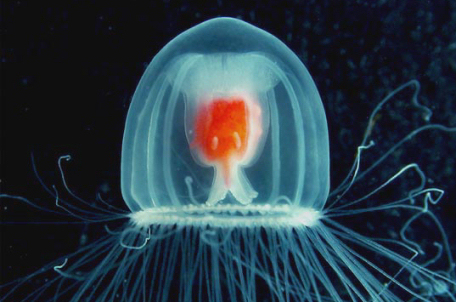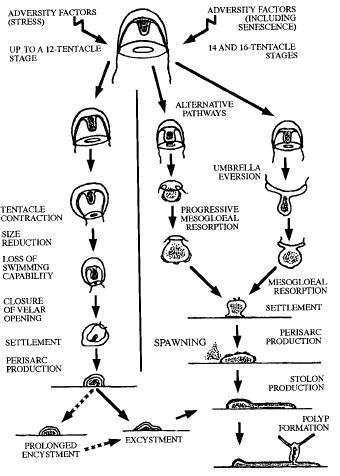On one of my recent safari’s through the internet jungle, I came across a remarkable little creature. It’s a small (maximum diameter about 4.5 millimeters) bell-shaped jellyfish, with a number of tentacles ranging from 8 in young specimens to 90 in adult ones.
It’s name is Turritopsis nutricula (see figure 1), and it can actually age backwards. A cnidarian Benjamin Button, as it were.

Figure 1: The immortal jellyfish, T. nutricula.
(Source: zmescience)
When it finds itself in adverse conditions, the medusa stage (the free-living jellyfish stage, in contrast to the sedentary polyp stage) can undergo a specific transformational process enabling this small organism to revert back to polyp stage (Bavestrello et al., 1992; Piraino et al., 1996).
This process can take place through a few alternative pathways (see figure 2). When the medusa is relatively young (up to the 12 tentacle stage), the bell regresses and the tentacles contract. The animal gets smaller, loses its swimming capacity, and the velar opening (the ring to which the tentacles are attached) closes, after which it settles. Then, the perisarc (horny external covering) is produced, and either there follows a period of encystment, or it directly forms stolons and, eventually, polyps.

Figure 2: Pathways through which T. nutricula can revert to polyp stage.
(Source: Piraino et al., 1996)
When the organisms are older (and thus have more tentacles), two routes can be followed in the age reversal process. Either the umbrella inverses, followed by mesogleal (the ‘jelly’) reabsorption, or the mesoglea can be reabsorbed directly, without umbrella inversion. Then, it settles, produces the perisarc and stolons, and eventually reverts to the polyp stage. So, in theory, a medusa can revert to a polyp, which can start a polyp colony, which, in turn, will produce new copies of the original medusa (Piraino et al., 2004).
For this to work, however, some cell types need to be present, specifically tissue cells from the surface of the bell, and cells of the gastrovascular system (Piraino et al., 1996). Furthermore, this ‘potential for immortality’ has, so far, been observed only in laboratory conditions, since the process is fairly fast. Besides, most jellyfish succumb to the dangers of life, such as being eaten or contracting disease, without being able to use their remarkable ‘reversed development’.
More recent research hints at the presence of the potential for RD, or reversed development, in other Cnidarians. For example, exposure to cesium chloride has been shown to induce RD, in different degrees, in Hydractinia carnea, where RD was present but limited to young medusa buds, and in Turritopsis dohrnii, where RD was more extensive (Schmich et al., 2007).

References
Bavestrello, G.; Sommer, C. and Sarà, M. (1992). Bi-directional conversion in Turritopsis nutricula. Scientia Marina. 56(2 – 3), pp. 137 – 140. (Click here for the article)Piraino, S.; Boero, F.; Aeschbach, B. and Schmid, V. (1996). Reversing the Life Cycle: Transforming into Polyps and Cell Transdifferentiation in Turritopsis Nutricula. The Biological Bulletin. 190, pp. 302 – 312. (Click here for the article)
Piraino, S.; De Vito, D.; Schmich, J., Bouillon, J. and Boero, F. (2004). Reverse development in Cnidaria. Canadian Journal of Zoology. 82(11), pp. 1748 – 1754. (Get it here)
Schmich, J.; Kraus, Y.; De Vito, D.; Graziussi, D., Boero, F. and Piraino, S. (2007). Induction of reverse development in two marine Hydrozoans. International Journalof Developmental Biology. 51, pp. 45 – 56. (You can get the article here)



Comments